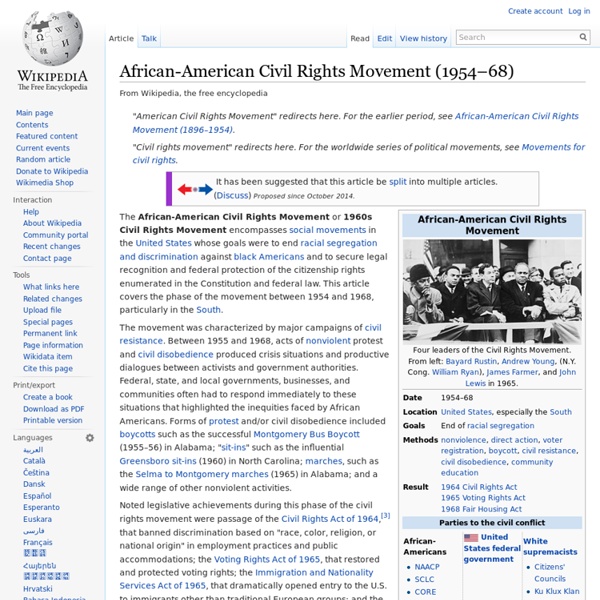Veterans of the Civil Rights Movement
Literacy Tests & Voter Applications Alabama Georgia
Acid Tests
The Acid Tests were a series of parties held by author Ken Kesey in the San Francisco Bay Area during the mid-1960s, centered entirely around the use of, experimentation with, and advocacy of, the psychedelic drug LSD, also known as "acid." See also[edit] Merry Pranksters
What can Teachers Learn from Nelson Mandela to Make a Difference?
We teach language to help people communicate. Why do people want to communicate? To express the human story through myth, inspiration and powerful transformation. Let’s dig deeper into the story of Nelson Mandela and help our students think, communicate and become active narrators in the search for peace and what makes us human. What can we teach students about Nelson Mandela through the power of video and multi-media? Let’s dig a little deeper to find out;)
"Black Power" Era
The impressive March on Washington in the summer of 1963 has been remembered as one of the great successes of the Civil Rights Movement, a glorious high point in which a quarter of a million people—black and white—gathered at the nation's capital to demonstrate for "freedom now." But for many African Americans, especially those living in inner-city ghettos who discovered that nonviolent boycotts and sit-ins did little to alter their daily lives, the great march of 1963 marked only the first stage of a new, more radical phase of the Civil Rights Movement. You probably just finished reading the first chapter of the Civil Rights Movement.
Benjamin Spock
Benjamin McLane Spock (May 2, 1903 – March 15, 1998) was an American pediatrician whose book Baby and Child Care, published in 1946, is one of the best-sellers of all time. Throughout its first 52 years, Baby and Child Care was the second-best-selling book, next to the Bible.[1] Its message to mothers is that "you know more than you think you do."[2]
Scrapping the 1998 Human Rights Act: what would it mean?
Scrapping the 1998 Human Rights Act introduced by Labour does not mean that British courts would no longer have to apply the European convention on human rights. British citizens would still be able to take cases to the European court of human rights, and its case law and the principles of the convention would still be in force in UK courts. Britons who want to bring cases would, however, no longer be able to have them heard by a high court first. Instead, they would face delays and extra costs in taking cases directly to Strasbourg.
Desegregation
The Civil Rights Movement is sometimes defined as a struggle against racial segregation that began in 1955 when Rosa Parks, the "seamstress with tired feet," refused to give up her seat to a white man on a bus in Alabama. Brown v. Board of Education, the 1954 Supreme Court case that attacked the notion of "separate but equal," has also been identified as the catalyst for this extraordinary period of organized boycotts, student protests, and mass marches. These legendary events, however, did not cause the modern Civil Rights Movement, but were instead important moments in a campaign of direct action that began two decades before the first sit-in demonstration.
Bill Ayers
He is a retired professor in the College of Education at the University of Illinois at Chicago, formerly holding the titles of Distinguished Professor of Education and Senior University Scholar.[3] During the 2008 US presidential campaign, a controversy arose over his contacts with then-candidate Barack Obama. He is married to Bernardine Dohrn, who was also a leader in the Weather Underground. Early life[edit] In 1965, Ayers joined a picket line protesting an Ann Arbor, Michigan pizzeria for refusing to seat African Americans. His first arrest came for a sit-in at a local draft board, resulting in 10 days in jail. His first teaching job came shortly afterward at the Children's Community School, a preschool with a very small enrollment operating in a church basement, founded by a group of students in emulation of the Summerhill method of education.[9]
Mahatma Gandhi
Mohandas Karamchand Gandhi (pronounced [ˈmoːɦənd̪aːs ˈkərəmtʃənd̪ ˈɡaːnd̪ʱi] ( ); 2 October 1869 – 30 January 1948) was the preeminent leader of Indian nationalism in British-ruled India. Employing nonviolent civil disobedience, Gandhi led India to independence and inspired movements for civil rights and freedom across the world. The honorific Mahatma (Sanskrit: "high-souled", "venerable"[2])—applied to him first in 1914 in South Africa,[3]—is now used worldwide.


